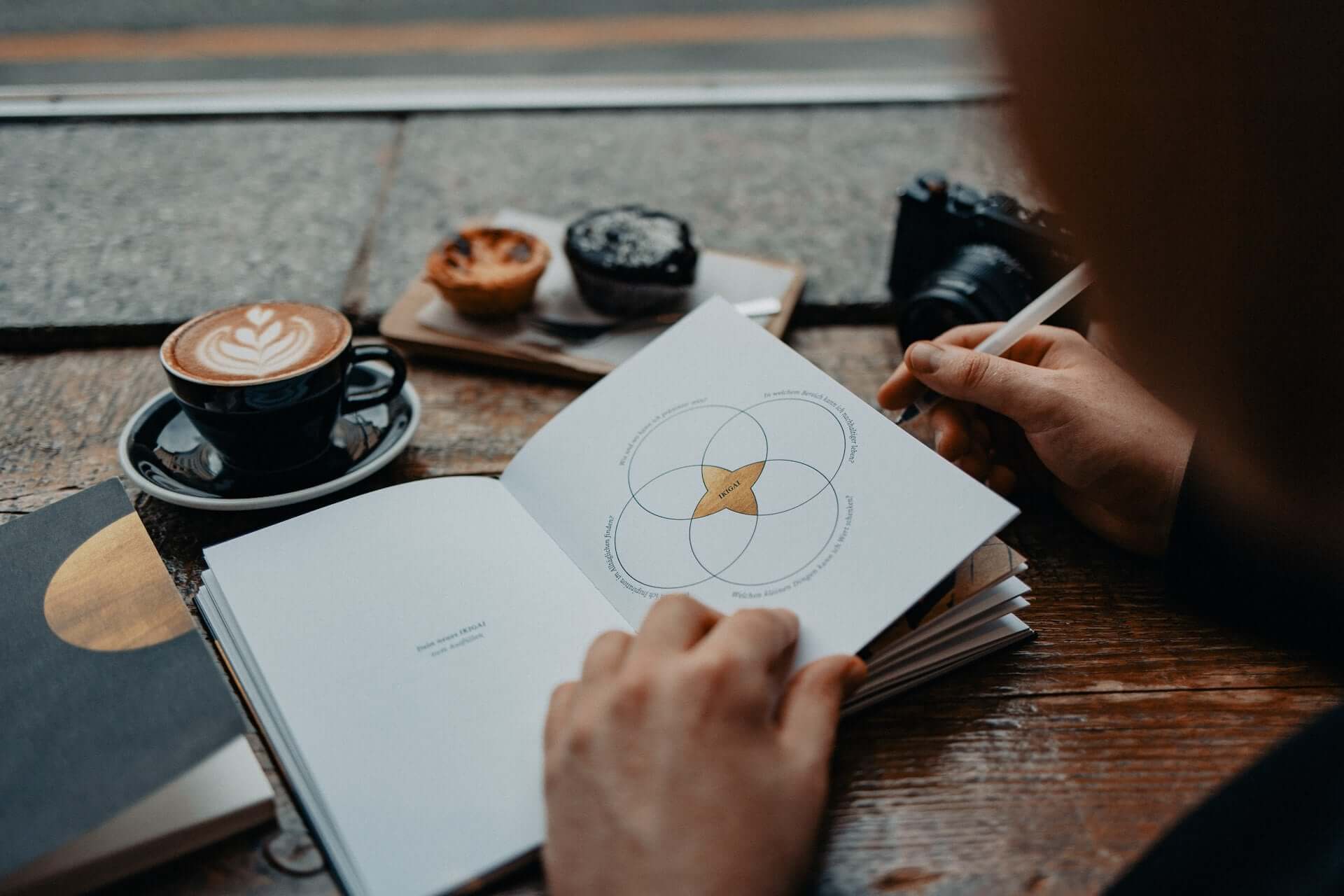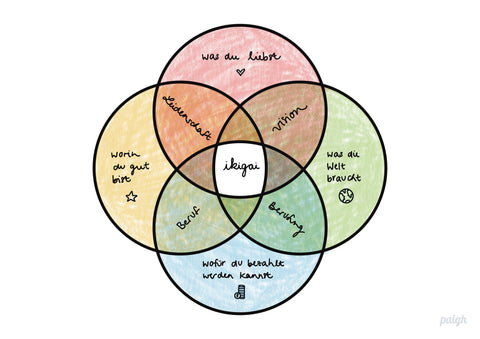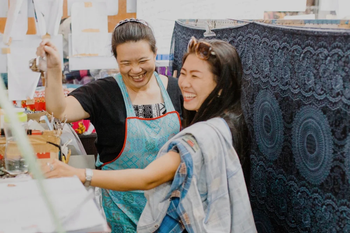
Table of contents
The Ikigai Method: Towards a More Fulfilling Life (EXERCISE)
What gives our lives meaning is different for every person. The Ikigai method is a concept that is intended to help us find this very individual meaning in life. This happens primarily through a specific and simple exercise. All you need is time, a pen and paper.
“Ikigai” is Japanese and stands for “meaning of life" or "the feeling of having something worth getting up for in the morning“, and can therefore also be understood as a philosophy of life. What was originally meant by it and how Ikigai is interpreted today, especially in the West, you can read in more detail here. At the center of the Ikigai method is a diagram made up of four circles that intersect. The intersection of all four areas represents Ikigai – the “meaning of life”. Each circle represents its own section: what we like to do, what we're good at, what we can get paid for, and what the world needs.

The diagram can be easily converted into one Reflection exercise transform what we're talking about today. It can help you get closer to the meaning of your life.
The Ikigai Method: Try it for yourself
Let me say in advance: Maybe you will find your Ikigai today with this exercise, but maybe not. Both are completely fine, because the point of this exercise is primarily to get started and reflect on yourself.
For the exercise you ideally have around the 30 minutes time and one Note and Pen are ready. Try not to think too hard about the things you're about to write down. Above all, write down what comes to mind first.
Step 1: Preparation
Draw a horizontal and a vertical line down the middle of your piece of paper so that you four equal sections receive. These four areas represent the four circles from the diagram. Now start in the top left section and write the question “1. What do I like to do?” into it. Then continue counterclockwise and fill the other three areas with the questions “2. What am I good at?”, “3. What can I get paid for?” and “4. What does the world need?”

Step 2: Fill the areas with content
Now it's time to answer the questions. Approach the areas individually and ideally take them 3-5 minutes per section Time.
We want to start with the simplest question and then work our way slowly:
1. What do I like to do?
The following questions can help answer this question:
Example answers:
- have deep conversations
- read exciting stories/books
- write/keep a diary
- cook
2. What am I good at?
The following questions can help answer this question:
Example answers:
- Accounting
- sing
- listen to other people
- Write stories and essays
3. What can I get paid for?
The following questions can help answer this question:
Example answers:
- marketing
- Write blogs
- Accounting
- Singing performances at weddings
4. What does the world need?
This question is the most difficult for most people. We therefore want to approach answering the question in small steps. Don't ask yourself what “the world” needs, but rather, what “your world” needs: The society in which you live; your immediate environment. The reality in which you currently find yourself.
Example answers:
- People need more fun and less stress
- more with each other, less against each other
- Impulses & stories that inspire people and make them think differently
Step 3: Find your Ikigai
Take a look at all the areas again and maybe add things that you would like to add.
Now let’s get to the exciting part: your Ikigai. From the four areas, choose what overlaps or what appears again and again. For this it may be that you have a little creative or you think about how different things can be combined with each other. You have to have some specific activities or skills abstracted to find an intersection of the areas. So “I’m good at painting and enjoy doing it” and “I’ve been paid to write song lyrics” and “the people around me need something that makes them happy / lets them escape from everyday life” can be summarized as “Creativity & Expression”.
In our example, the intersection would be something like “writing meaningful/inspiring stories.” – Great, then we’re done now, right?
Ikigai is a process
Unfortunately, it's often not that simple. Not all of us find our personal Ikigai straight away. Some people need days, months or even years. Some people will find that the contents of the four circles or areas change depending on the stage or phase of life. All of that is okay.
The original “promise” that you will inevitably find your own meaning in life with the Ikigai diagram not always fulfilled or complied with. But if we don't see this as the goal of the exercise, but rather see it as an opportunity to get to know ourselves better and navigate in a direction that corresponds to our idea of a fulfilling life, then Ikigai can bring us a lot.
Maybe it will help you that you have simply thought more about these areas and found them Starting points for things you can change in your life. Finding your own Ikigai is a constant process. Take your time. Keep asking yourself difficult and challenging questions and answer them honestly. Reflect on yourself and those around you regularly. Be open to trying new things and stepping out of your comfort zone - because until you try something, you can't know whether you'll enjoy it. The “meaning of your life” is often not one thing that stays the same forever. Dare to think in different directions and test them out.
If you would like to learn more about topics such as mindfulness & spirituality, sustainability, family and pregnancy or healthy eating, Check out exciting blog articles about it here.

Photo by Tarun Savvy on Unsplash



























Leave a comment
This site is protected by hCaptcha and the hCaptcha Privacy Policy and Terms of Service apply.